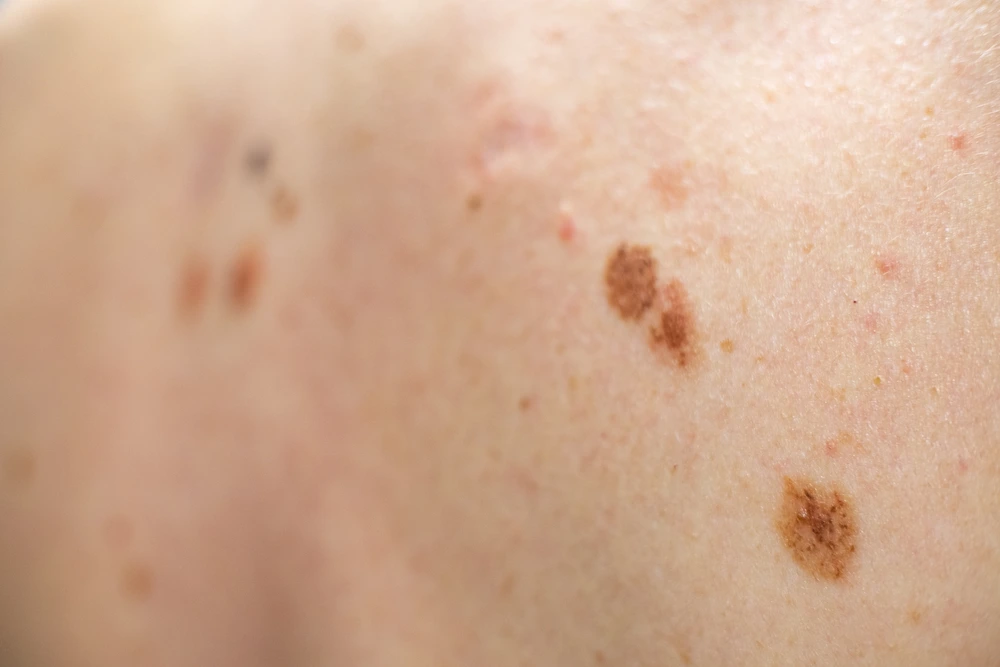Atypical Mole: Understanding Skin Changes

Moles, those small, pigmented spots on our skin, are a common occurrence. While most moles are harmless, some can exhibit unusual characteristics, raising concerns about their potential for developing into skin cancer.
If you’ve noticed a new or changing mole, especially one that looks different from your other moles, you might be wondering if it’s an atypical mole. This article provides a comprehensive guide to understanding atypical moles, their potential risks, and when to seek medical evaluation in Miami.
What is a Mole on Skin?
A mole, also known as a nevus, is a growth on the skin that develops when pigment cells (melanocytes) cluster together. Moles can vary in size, shape, and color, and they can appear anywhere on the body.
Types of Moles
- Common Moles: These are typically small, round, and evenly colored. They can be flat or raised and are usually harmless.
- Atypical Moles (Dysplastic Nevi): These moles have irregular features, such as uneven color, asymmetrical shape, and larger size. They have a higher risk of developing into melanoma, a type of skin cancer.
Atypical Mole: Recognizing the Characteristics
Atypical moles, also known as dysplastic nevi or atypical nevi, often have the following features:
- Asymmetry: One half of the mole doesn’t match the other half.
- Border Irregularity: The border is uneven, notched, or blurred.
- Color Variation: The mole has multiple colors, such as brown, black, tan, red, or blue.
- Diameter: Larger than 6 millimeters (about the size of a pencil eraser).
- Evolving: The mole is changing in size, shape, or color.

Non-Cancerous Moles: Monitoring for Changes
Most moles are non-cancerous (benign). However, it’s essential to monitor your moles for any changes, as these changes could indicate a potential problem.
Precancerous Mole: A Warning Sign
A precancerous mole, also known as a dysplastic nevus, has a higher risk of developing into melanoma. If you have a precancerous mole, your doctor might recommend regular monitoring or removal to prevent cancer development.
Atypical Mole: When to See a Doctor
If you notice any of the following, it’s crucial to consult a doctor or dermatologist in Miami:
- A new mole that appears after age 30
- A mole that is changing in size, shape, or color
- A mole that is asymmetrical, has irregular borders, or has multiple colors
- A mole that is larger than 6 millimeters in diameter
- A mole that is bleeding, itching, or painful
Primary Care Doctor in Miami: Your Partner in Skin Health
Your primary care doctor in Miami can play a vital role in monitoring your skin health and identifying potential skin cancer risks. They can:
- Perform a skin exam to assess your moles.
- Provide guidance on sun protection and skin cancer prevention.
- Refer you to a dermatologist for further evaluation or treatment.
Key Takeaways:
- An atypical mole, or dysplastic nevus, is a mole with irregular features that has a higher risk of developing into melanoma.
- If you have any concerns about a mole, consult a primary care doctor or dermatologist in Miami.
- Early detection and treatment are crucial for preventing skin cancer.
Remember, this article is intended for informational purposes only and should not be considered a substitute for professional medical advice. If you have any concerns about your health or skin, consult a qualified healthcare professional.
FAQs: Atypical Mole
- Are all atypical moles cancerous?
No, not all atypical moles are cancerous. However, they have a higher risk of developing into melanoma compared to common moles. It’s important to monitor them for any changes and consult a dermatologist if you notice anything unusual. - How often should I check my moles?
It’s recommended to perform a self-skin exam monthly to check your moles for any changes in size, shape, or color. Additionally, schedule regular skin exams with a dermatologist, especially if you have a family history of skin cancer or multiple moles. - Can atypical moles be removed?
Yes, atypical moles can be removed by a dermatologist if they are considered suspicious or if you’re concerned about their appearance. Removal methods include excision (cutting out the mole) or shave biopsy (shaving off the mole). - What are the chances that an atypical mole will turn into cancer?
The exact risk varies depending on individual factors, such as the number of atypical moles you have, your family history of melanoma, and sun exposure. However, the overall risk of an atypical mole developing into melanoma is relatively low. - I’m concerned about a mole on my skin. How can I find a dermatologist in Miami?
Your primary care doctor can provide a referral to a dermatologist in Miami. You can also search online for “dermatologist near me in Miami” or ask for recommendations from friends or family.
Contact Us
Hiriart & Lopez MD, LLC
9950 SW 107th Ave STE 101,
Miami, FL 33176
305-274-8779
Phone: (305) 274-8779
Fax: (305) 274-0646
OPENING HOURS
Monday 7:30 AM–4:30 PM
Tuesday 7:30 AM–4:30 PM
Wednesday 7:30 AM–4:30 PM
Thursday 7:30 AM–4:30 PM
Friday 7:30–11 AM
Saturday Closed
Sunday Closed
OFFICE LOCATION
Atypical Mole: Understanding Skin Changes

Moles, those small, pigmented spots on our skin, are a common occurrence. While most moles are harmless, some can exhibit unusual characteristics, raising concerns about their potential for developing into skin cancer.
If you’ve noticed a new or changing mole, especially one that looks different from your other moles, you might be wondering if it’s an atypical mole. This article provides a comprehensive guide to understanding atypical moles, their potential risks, and when to seek medical evaluation in Miami.
What is a Mole on Skin?
A mole, also known as a nevus, is a growth on the skin that develops when pigment cells (melanocytes) cluster together. Moles can vary in size, shape, and color, and they can appear anywhere on the body.
Types of Moles
- Common Moles: These are typically small, round, and evenly colored. They can be flat or raised and are usually harmless.
- Atypical Moles (Dysplastic Nevi): These moles have irregular features, such as uneven color, asymmetrical shape, and larger size. They have a higher risk of developing into melanoma, a type of skin cancer.
Atypical Mole: Recognizing the Characteristics
Atypical moles, also known as dysplastic nevi or atypical nevi, often have the following features:
- Asymmetry: One half of the mole doesn’t match the other half.
- Border Irregularity: The border is uneven, notched, or blurred.
- Color Variation: The mole has multiple colors, such as brown, black, tan, red, or blue.
- Diameter: Larger than 6 millimeters (about the size of a pencil eraser).
- Evolving: The mole is changing in size, shape, or color.

Non-Cancerous Moles: Monitoring for Changes
Most moles are non-cancerous (benign). However, it’s essential to monitor your moles for any changes, as these changes could indicate a potential problem.
Precancerous Mole: A Warning Sign
A precancerous mole, also known as a dysplastic nevus, has a higher risk of developing into melanoma. If you have a precancerous mole, your doctor might recommend regular monitoring or removal to prevent cancer development.
Atypical Mole: When to See a Doctor
If you notice any of the following, it’s crucial to consult a doctor or dermatologist in Miami:
- A new mole that appears after age 30
- A mole that is changing in size, shape, or color
- A mole that is asymmetrical, has irregular borders, or has multiple colors
- A mole that is larger than 6 millimeters in diameter
- A mole that is bleeding, itching, or painful
Primary Care Doctor in Miami: Your Partner in Skin Health
Your primary care doctor in Miami can play a vital role in monitoring your skin health and identifying potential skin cancer risks. They can:
- Perform a skin exam to assess your moles.
- Provide guidance on sun protection and skin cancer prevention.
- Refer you to a dermatologist for further evaluation or treatment.
Key Takeaways:
- An atypical mole, or dysplastic nevus, is a mole with irregular features that has a higher risk of developing into melanoma.
- If you have any concerns about a mole, consult a primary care doctor or dermatologist in Miami.
- Early detection and treatment are crucial for preventing skin cancer.
Remember, this article is intended for informational purposes only and should not be considered a substitute for professional medical advice. If you have any concerns about your health or skin, consult a qualified healthcare professional.
FAQs: Atypical Mole
- Are all atypical moles cancerous?
No, not all atypical moles are cancerous. However, they have a higher risk of developing into melanoma compared to common moles. It’s important to monitor them for any changes and consult a dermatologist if you notice anything unusual. - How often should I check my moles?
It’s recommended to perform a self-skin exam monthly to check your moles for any changes in size, shape, or color. Additionally, schedule regular skin exams with a dermatologist, especially if you have a family history of skin cancer or multiple moles. - Can atypical moles be removed?
Yes, atypical moles can be removed by a dermatologist if they are considered suspicious or if you’re concerned about their appearance. Removal methods include excision (cutting out the mole) or shave biopsy (shaving off the mole). - What are the chances that an atypical mole will turn into cancer?
The exact risk varies depending on individual factors, such as the number of atypical moles you have, your family history of melanoma, and sun exposure. However, the overall risk of an atypical mole developing into melanoma is relatively low. - I’m concerned about a mole on my skin. How can I find a dermatologist in Miami?
Your primary care doctor can provide a referral to a dermatologist in Miami. You can also search online for “dermatologist near me in Miami” or ask for recommendations from friends or family.
Contact Us
Hiriart & Lopez MD, LLC
9950 SW 107th Ave STE 101,
Miami, FL 33176
305-274-8779
Phone: (305) 274-8779
Fax: (305) 274-0646
OPENING HOURS
Monday 7:30 AM–4:30 PM
Tuesday 7:30 AM–4:30 PM
Wednesday 7:30 AM–4:30 PM
Thursday 7:30 AM–4:30 PM
Friday 7:30–11 AM
Saturday Closed
Sunday Closed

